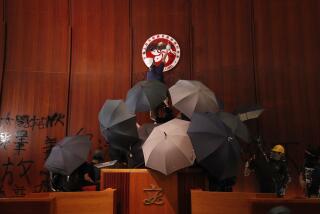3 Get 16-, 20-Year, Life Sentences for Defacing Beijing Portrait of Mao
- Share via
BEIJING — A Chinese court imposed prison sentences of life, 20 years and 16 years on three men who flung ink and paint on the giant portrait of the late ruler Mao Zedong in Beijing’s Tian An Men Square during anti-government unrest in May.
The Beijing Evening News said the capital’s Intermediate Court found Yu Zhijian, Yu Dongyue and Lu Decheng from south China’s Hunan Province guilty of “counterrevolutionary destruction and counterrevolutionary incitement.”
The prison terms are among the few court sentences Chinese authorities have announced since the bloody military crackdown June 3 and 4 and subsequent arrests of thousands of anti-government protesters.
The three pasted “reactionary posters” on the Gate of Heavenly Peace at the north end of the giant square before throwing paint-filled eggshells and an ink bottle at Mao’s portrait May 23, the paper said.
“They used the turmoil in Beijing as an opportunity to put up reactionary posters, make reactionary speeches . . . and brazenly carried out counterrevolutionary destruction on Tian An Men Square,” it quoted the court as saying.
“Their actions constitute . . . counterrevolutionary destruction and counterrevolutionary incitement. They must be severely punished,” it added.
The three, described in earlier reports as a primary schoolteacher, a newspaper arts editor and a transport company worker, were seized by student democracy activists then filling Tian An Men Square and handed over to police after defacing the picture.
National television showed the three men standing impassively as court officials read out their sentences. Yu Zhijian was jailed for life, Yu Dongyue for 20 years and Lu 16.
Mao’s portrait has hung since the 1950s from the Gate of Heavenly Peace at the entrance to the Forbidden City, the ancient imperial palace complex in the center of Beijing.
A sign reading, “This Was Not Done by Students or the People,” appeared below the defaced portrait and student leaders condemned the action.
Authorities quickly replaced the painting with an identical, undamaged one.
The attack went against the grain of a limited revival of Mao’s memory during the weeks of unrest, when some workers on protest marches carried his portrait in the first such public display of devotion to him in the capital in a decade.
More to Read
Sign up for Essential California
The most important California stories and recommendations in your inbox every morning.
You may occasionally receive promotional content from the Los Angeles Times.













